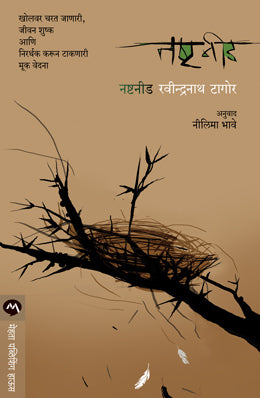NASHTNEED
NASHTNEED is backordered and will ship as soon as it is back in stock.
Couldn't load pickup availability
Genuine Products Guarantee
Genuine Products Guarantee
We guarantee 100% genuine products, and if proven otherwise, we will compensate you with 10 times the product's cost.
Delivery and Shipping
Delivery and Shipping
Products are generally ready for dispatch within 1 day and typically reach you in 3 to 5 days.
📘 Book Details
-
Translator: Nilima Bhave
-
Publisher: Mehta Publishing House
-
Language: Marathi (Translated from Bengali)
-
Edition: 2nd Edition
-
Year of Publication: June 2010
-
ISBN: 9788184981193
-
Pages: 164
-
Cover: Paperback
-
Category: Short Stories
📝 About The Book
Rabindranath Tagore, one of the most revered voices in Indian literature, has often explored the theme of emotional entanglements outside marriage—not as moral failings but as deeply personal human experiences. This Marathi translation by Nilima Bhave brings together three of Tagore’s classic novellas: ‘Nashtaneed’ (Broken Nest), ‘Malaneh’ (Flower Garden), and ‘Dui Boan’ (Two Sisters), each narrating a unique emotional journey that challenges traditional views on marital fidelity and individual longing.
-
In ‘Nashtaneed’, made famous by Satyajit Ray’s film Charulata, Charu drifts emotionally toward her brother-in-law when her husband, Bhupati, becomes increasingly absorbed in his work.
-
In ‘Malaneh’, Aditya is drawn to his childhood friend Sarala when his ailing wife Neeraja is bedridden, leaving a void in his life.
-
‘Dui Boan’ tells the story of Shashank, who finds solace in his sister-in-law Urmila’s presence when his strong-willed wife Sharmila falls ill.
Despite the similar thematic core, each story unfolds differently, influenced by the temperaments of the characters involved. Tagore masterfully avoids passing judgment—no one is portrayed as purely right or wrong. The tension arises not from acts of betrayal, but from unmet emotional needs and the complexities of human relationships.
First published nearly 75 years ago, these novellas were considered bold and controversial for their time. Yet today, they feel startlingly relevant, especially for modern readers who appreciate stories that approach delicate emotional topics with nuance, sensitivity, and psychological depth.
This collection stands out for its quiet emotional turbulence, moral neutrality, and Tagore’s empathetic portrayal of individuals navigating the intricate terrain of love, companionship, and solitude.







